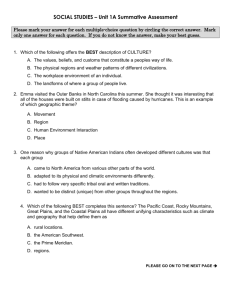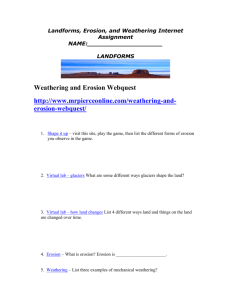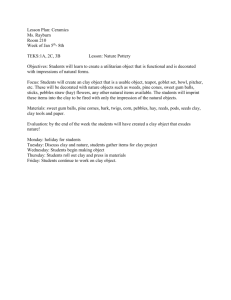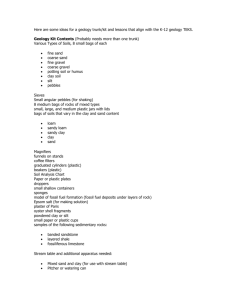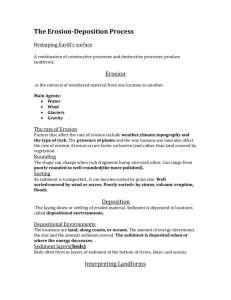Erosion by Water
advertisement
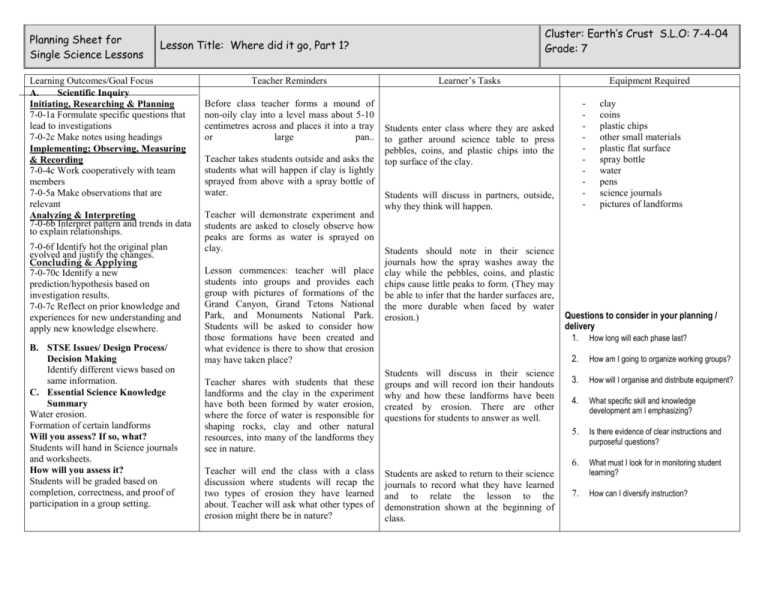
Planning Sheet for Single Science Lessons Cluster: Earth’s Crust S.L.O: 7-4-04 Grade: 7 Lesson Title: Where did it go, Part 1? Learning Outcomes/Goal Focus A. Scientific Inquiry Initiating, Researching & Planning 7-0-1a Formulate specific questions that lead to investigations 7-0-2c Make notes using headings Implementing; Observing, Measuring & Recording 7-0-4c Work cooperatively with team members 7-0-5a Make observations that are relevant Analyzing & Interpreting 7-0-6b Interpret pattern and trends in data to explain relationships. 7-0-6f Identify hot the original plan evolved and justify the changes. Concluding & Applying 7-0-70c Identify a new prediction/hypothesis based on investigation results. 7-0-7c Reflect on prior knowledge and experiences for new understanding and apply new knowledge elsewhere. B. STSE Issues/ Design Process/ Decision Making Identify different views based on same information. C. Essential Science Knowledge Summary Water erosion. Formation of certain landforms Will you assess? If so, what? Students will hand in Science journals and worksheets. How will you assess it? Students will be graded based on completion, correctness, and proof of participation in a group setting. Teacher Reminders Before class teacher forms a mound of non-oily clay into a level mass about 5-10 centimetres across and places it into a tray or large pan.. Teacher takes students outside and asks the students what will happen if clay is lightly sprayed from above with a spray bottle of water. Teacher will demonstrate experiment and students are asked to closely observe how peaks are forms as water is sprayed on clay. Lesson commences: teacher will place students into groups and provides each group with pictures of formations of the Grand Canyon, Grand Tetons National Park, and Monuments National Park. Students will be asked to consider how those formations have been created and what evidence is there to show that erosion may have taken place? Teacher shares with students that these landforms and the clay in the experiment have both been formed by water erosion, where the force of water is responsible for shaping rocks, clay and other natural resources, into many of the landforms they see in nature. Teacher will end the class with a class discussion where students will recap the two types of erosion they have learned about. Teacher will ask what other types of erosion might there be in nature? Learner’s Tasks Equipment Required - Students enter class where they are asked to gather around science table to press pebbles, coins, and plastic chips into the top surface of the clay. Students will discuss in partners, outside, why they think will happen. Students should note in their science journals how the spray washes away the clay while the pebbles, coins, and plastic chips cause little peaks to form. (They may be able to infer that the harder surfaces are, the more durable when faced by water erosion.) Students will discuss in their science groups and will record ion their handouts why and how these landforms have been created by erosion. There are other questions for students to answer as well. Students are asked to return to their science journals to record what they have learned and to relate the lesson to the demonstration shown at the beginning of class. clay coins plastic chips other small materials plastic flat surface spray bottle water pens science journals pictures of landforms Questions to consider in your planning / delivery 1. How long will each phase last? 2. How am I going to organize working groups? 3. How will I organise and distribute equipment? 4. What specific skill and knowledge development am I emphasizing? 5. Is there evidence of clear instructions and purposeful questions? 6. What must I look for in monitoring student learning? 7. How can I diversify instruction?
